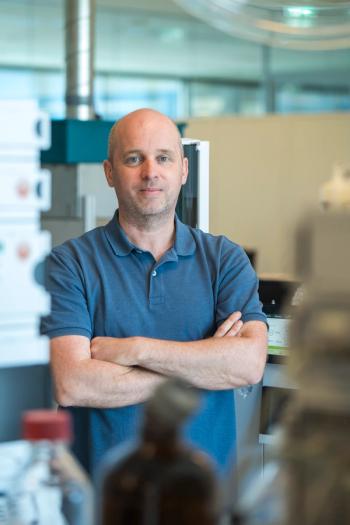
- January 2021
- Volume 17
- Issue 01
The Starring Role of GC–MS in Bioanalysis
The Column spoke to Martin Giera of Leiden University Medical Center about his innovative research using GC–MS in bioanalysis applications.
The Column spoke to Martin Giera of Leiden University Medical Center in the Netherlands, about the importance of gas chromatography‑mass spectrometry (GC–MS) in bioanalysis applications and the latest advances he has made with this technique.
Q. You and your team have developed a lot of interesting methods using gas chromatography‑mass spectrometry (GC–MS) in bioanalysis. Is GC–MS an underrated technique in bioanalysis, and what benefits can it offer over liquid chromatography‑mass spectrometry (LC–MS) methods?
A: Well, I guess it has been the workhorse in bioanalysis for many years prior to the ascent of LC–MS. However, in the early 2000s people started to move away from GC–MS towards triple quadrupole mass spectrometry (QqQ)‑based liquid chromatography tandem mass spectrometry (LC–MS/MS) methods that offered enhanced sensitivity for hydrophilic analytes. Nevertheless, GC–MS is a very useful technique for lipophilic and neutral molecules, such as sterols, fatty acids, and fatty alcohols.
Q. You developed a GC–MS‑based whole-cell screening assay for the target identification of distal cholesterol biosynthesis (1). Why is the investigation of distal cholesterol biosynthesis important?
A: This pathway has been regarded as a mere transition from squalene to cholesterol for many years. However, several reports in the past decade, including our own, have underlined the bioactivities of the pathway intermediates and identified distal cholesterol biosynthesis as a possibly druggable pathway, particularly in the context of inflammatory diseases (2,3,4).
Q. What was novel about the GC–MS approach you developed and what benefits does it offer the analyst compared to previous techniques?
A: Most enzymes of distal cholesterol biosynthesis are membrane bound, which makes them hard to isolate and also affects their interaction with binding partners when removed from their natural environment. An interesting assay published by the group of Miguel Lasuncion used LC-scintillation analysis to study distal cholesterol biosynthesis (5).This assay formed the basis for our developments. As we did not want to work with hard-to-isolate enzymes or radioactivity we opted for a GC–MS‑based whole cell screening assay involving 13C-labelled substrates. This helped us to design a simple and robust assay, so we could investigate interactions with distal cholesterol biosynthesis. GC–MS was an ideal choice because it allowed the separation of all closely related intermediates of the pathway, as well as gathering characteristic mass spectra, which is obviously very useful for substance identification.
Q. What were your main findings?
A: Using this assay, we closed several gaps for yet unaddressed enzymes of the pathway, and designed and improved chemical probes for these proteins. Examples include lathosterol side-chain amides targeting lathosterol oxidase, several improved inhibitors of squalene epoxidase, and maybe most importantly, a series of selective and highly potent inhibitors of 24-dehydrocholesterol reductase (DHCR24) inhibitors. The latter has just recently been published in The Proceedings of the National Academy of Sciences (PNAS) (2) and provides a link between distal cholesterol biosynthesis and inflammation resolution. We have already taken this concept a step further and investigated DHCR24 inhibition in different mouse models of disease with very encouraging outcomes.
Q. You also used GC–MS to analyze short-chain fatty acids in faeces, cecum content, and blood samples (6). Why is this type of analysis important?
A: Short-chain fatty acids (SCFA) have been identified as an important link between the gut microbiome and our immune system. Consequently, this type of compound has taken centre stage in several research fields and especially microbiome-related investigations.
Q. What challenges did you encounter and what benefits does your approach offer the analyst?
A: Initially, we investigated silylation which didn’t really work because the derivatization agent eluted after some of our analytes, which caused some interference. Later we spotted the report by Tomcik et al. in Analytical Biochemistry (2011) (7) and decided to adopt their derivatization strategy, expanding it to our entire set of monitored fatty acids (C2–C24). That worked out quite nicely. We also compared this with reports on using hydrazine labelling in combination with LC–MS analysis. Frankly, in our hands, GC–MS performs a lot better than LC–MS and offers a significantly lower background noise, rendering GC–MS a better technique for the analysis of blood‑derived samples.
Q. Have you applied this to any interesting “real world” applications?
A: Yes, we investigated the gut brain axis and the satiety‑inducing effects of butyrate in mice (8)and the effects of SCFA on post‑stroke recovery (9). Interestingly, acute oral, but not intravenous, butyrate administration significantly reduced food intake in mice. This implies that butyrate acts on the gut-brain circuit and relates our results to nutritional observations and the beneficial effects of high dietary fibre intake. It would be interesting to expand this type of work and correlate gut and blood SCFA levels to general health status.
Q. Are you working on any other interesting approaches using GC–MS?
A: Unfortunately, not at the moment.Corona had quite some impact on our activities and at present we are trying hard to reduce our sample backlog. However, future plans include automated- and high‑throughput methods for sterol analysis to be applied in epidemiological cohorts. It will be quite a challenge designing a robust and automated method that is capable of measuring thousands, instead of dozens, of samples.
References
- C. Müller, J. Junker, F. Bracher, and M. Giera, Nat Protoc. 14(8), 2546–2570 (2019).
- A. Körner, E. Zhou, C. Müller, Y. Mohammed, S. Herceg, F. Bracher, P.C.N. Rensen, Y. Wang, V. Mirakaj, and M. Giera, Proc. Natl. Acad. Sci. USA.116(41), 20623–20634 (2019).
- Z. Hubler, D. Allimuthu, I. Bederman, M.S. Elitt, M. Madhavan, K.C. Allan, H.E. Shick, E. Garrison, M.T. Karl, D.C. Factor, Z.S. Nevin, J.L. Sax, M.A. Thompson, Y. Fedorov, J. Jin, W.K. Wilson, M. Giera, F. Bracher, R.H. Miller, P.J. Tesar, D.J. Adams, Nature 560(7718), 372–376 (2018).
- N.J. Spann, L.X. Garmire, J.G. McDonald, D.S. Myers, S.B. Milne, N. Shibata, D. Reichart, J.N. Fox, I. Shaked, D. Heudobler, C.R.H. Raetz, E.W. Wang, S.L. Kelly, M.C. Sullards, R.C. Murphy, A.H. Merrill Jr., H.A. Brown, E.A. Dennis, A.C. Li, K. Ley, S. Tsimikas, E. Fahy, S. Subramaniam, O. Quehenberger, D.W. Russell, and C.K. Glass, Cell. 151(1), 138–52 (2012).
- C. Fernández, M. Martín, D. Gómez-Coronado, and M.A. Lasunción, J. Lipid Res. 46(5), 920–9 (2005).
- L.R. Hoving, M. Heijink, V. van Harmelen, K.W. van Dijk, and M. Giera, Methods Mol. Biol. 1730, 247–256 (2018).
- K. Tomcik, R.A. Ibarra, S. Sadhukhan, Y. Han, G.P. Tochtrop, G.-F. Zhang, Anal. Biochem. 410(1), 110–117 (2011).
- Z. Li, C.-X. Yi, S. Katiraei, S. Kooijman, E. Zhou, C.K. Chung, Y. Gao, J.K. van den Heuvel, O.C. Meijer, J.F.P. Berbée, M. Heijink, M. Geira, K.W. van Dijk, A.K. Groen, P.C.N. Rensen, and Y. Wang, Gut 67(7), 1269–1279 (2018).
- R. Sadler, J.V. Cramer, S. Heindl, S. Kostidis, D. Betz, K.R. Zuurbier, B.H. Northoff, M. Heijink, M.P. Goldberg, E.J. Plautz, S. Roth, R. Malik, M. Dichgans, L.M. Holdt, C. Benakis, M. Giera, A.M. Stowe, and A. Liesz, J. Neurosci. 40(5), 1162–1173 (2020).
Martin Giera is Associate Professor and Head of the Metabolomics Group at the Leiden University Medical Center (LUMC) in the Netherlands. He studied pharmacy in Heidelberg and Munich (Germany) and obtained his Ph.D. degree in pharmaceutical chemistry from Ludwig-Maximilians Universität München (LMU), Germany, carrying out international postdoctoral training at the VU University Amsterdam, the Netherlands. He was an Assistant Professor at the VU University Amsterdam, Visiting Scientist at Harvard Medical School, USA, Head of the Lipid Analysis and Biology group at LUMC, and Visiting Professor at the Scripps research institute, USA. He is interested in immune cell metabolism, inflammation resolution and the use of metabolomics to define novel drug targets with a special focus on distal cholesterol biosynthesis and its druggability. Martin has been a DAAD fellow (The German Academic Exchange Service) and is a permanent member and chairman of the interdisciplinary committee of FWO (Flanders Science Foundation), Belgium. He served as Guest Editor for several journals and is consultant to different industry partners. He is on the editorial board of Frontiers in Molecular Biosciences and Metabolites (MDPI) and serves on the scientific advisory board of Cell Star Protocols. Martin is coordinator of the multinational H2020 ITN consortium ArthritisHeal.
E-mail: m.a.giera@lumc.nl
Website:
Articles in this issue
almost 5 years ago
12 Tips for Successful Chromatography in 2021almost 5 years ago
Trends and Developments in Data Handlingalmost 5 years ago
SCM-X 2021 Previewalmost 5 years ago
3D-Printed Metal Column Developed for Micro-GCalmost 5 years ago
LCGC Columnist Anurag Rathore Receives Agilent Thought Leader Awardalmost 5 years ago
Vol 17 No 1 The Column January 2021 North American PDFalmost 5 years ago
Vol 17 No 01 The Column January 2021 Europe & Asia PDFNewsletter
Join the global community of analytical scientists who trust LCGC for insights on the latest techniques, trends, and expert solutions in chromatography.





